If you have a paid social media budget, then you should seriously consider advertising on Instagram. Why?
Every month, Instagram ads reach 96.6% of Instagram’s active user base. That’s almost 2 billion potential customers in total! And the target group is still growing — Meta data shows that Instagram’s ad reach has jumped 21% over the past year, despite changes to its ad reporting.
This guide will walk you through how to advertise on Instagram, including a simple 8-step guide to creating your first Instagram ad.
What is Instagram Ads?
Instagram ads are posts that businesses can pay to show to specific target groups on Instagram.
These ads appear in users’ feeds, stories, and explore pages in the same format as organic content from other Instagram accounts.
Instagram ads can contain images, videos, carousels (multiple images), or collections (dynamic product galleries).
Instagram ads look just like regular posts, but always have a Sponsored tag to indicate they are ads. They also often have more features than regular posts, such as links, CTA buttons, and product tags.
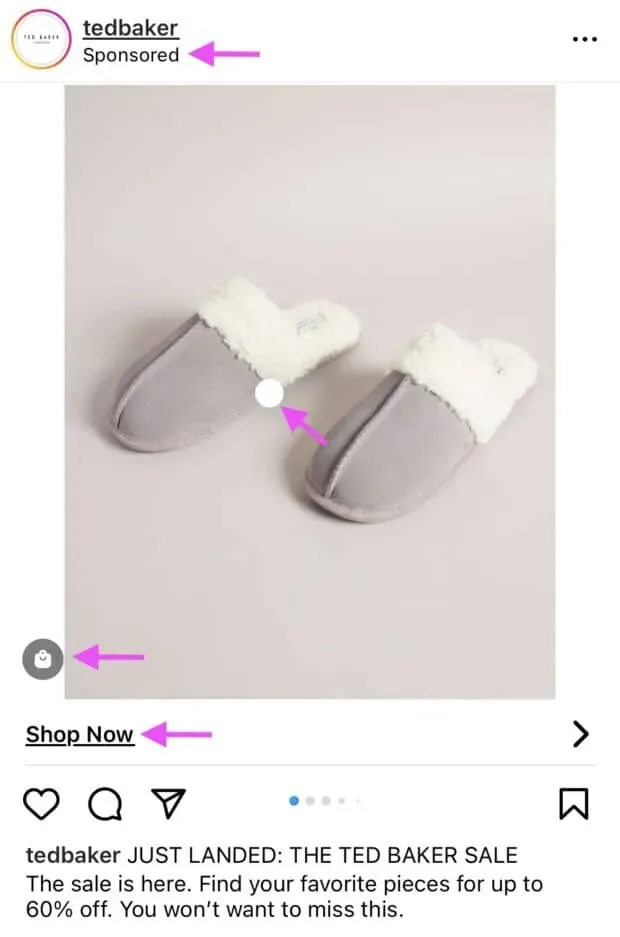
Source: Instagram (@tedbaker)
How much does Instagram advertising cost?
The cost of advertising on Instagram depends on the total budget, duration, and goals you have set for your ad or campaign. You can set a daily or lifetime budget for your Instagram ads, so it’s up to you how much you want to spend. Note that there is no best practice for how much to spend, but Meta recommends starting with at least $5 a day.
While there is no average or benchmark price, some cost factors may include:
- Targeting your specific audience
- Competitiveness of your industry
- Time of year (spending often increases during Q4 holiday shopping periods such as Black Friday)
- Your chosen placement (costs may vary between ads shown on Facebook and Instagram)
Advertisers can set their own maximum bids for each auction or let Instagram optimize them automatically. So, if you’re new to Instagram advertising, it’s best to start with a low max bid to gain experience.
Once you have a better understanding of the competitive landscape for your chosen industry and demographics, you will be able to decide whether to increase your maximum bid. We will explain this in more detail in our 8 step guide below.
The best way to estimate your budget is to create a campaign draft in Instagram Ad Manager and look for the Audience Definition and Estimated Daily Results modules that will tell you if your budget settings will be sufficient to reach your desired audience within your desired range. campaign duration.
Types of advertising on Instagram.
There are many different ad formats on Instagram, including:
- Image Ads
- story advertising
- Video ads
- carousel ads
- Ad collection
- Explore Ads
- Shopping ads
- Drum advertisement
The wide range means you can choose the best ad type that suits your specific business goals. Instagram ads now support six simplified campaign objectives. The call-to-action options will vary depending on the ad type and purpose you choose. Read more about this below.
Image Ads
Instagram image ads allow businesses to use individual images to advertise their brand, products, and services.

Source: Instagram (@thursdays)
Instagram image ads are best for campaigns with compelling visual content that can be conveyed in a single image. These images can be created from high quality photography or designs and illustrations.
It is also possible to add text to images. However, Instagram recommends limiting overlay text as much as possible for accessibility and best results.
Video ads
Instagram video ads are a great way to showcase your product or service in an engaging and engaging way. You can use video ads to showcase how products work, highlight unique features, or simply tell your brand story.
Feed video ads can be up to 60 minutes long, but shorter videos are usually more effective. Learn more about the specifications of Instagram ads in our guidelines for designing an Instagram video ad blog.
Source: Instagram (@the_oodie)
story advertising
Instagram Stories ads are full-screen image or video ads that appear between users’ stories.
Instagram Stories is a widely used part of the app, with over 500 million Instagram users viewing stories every day. Ad engagement in Stories is often higher as the format spans the mobile phone screen and feels much more immersive than feed ads.
The best Instagram Stories ads look and feel like regular Stories and don’t stand out as ads. When designing ads for stories, businesses can use all of the standard features of Instagram Stories, such as filters, text, GIFs, and interactive stickers.
Source: Instagram (@campbellscanada)
Stories ads can use photos, videos, and carousels. The call to action is presented as a swipeable link at the bottom of the story.
Source: Instagram (@woodscanada)
carousel ads
An Instagram carousel ad is a series of images or videos that users can scroll through. They can appear in both the feed and Instagram stories, with a call-to-action button or a link that takes users straight to your site.
You can use carousel ads to:
- Showcase a collection of related products
- Tell a multi-part story
- Share up to 10 images or videos
Source: Instagram (@bashparis)
Ad collection
Instagram collection ads are a combination of carousel ads and shopping ads. Collection ads showcase products directly from your product catalog.
Collection ads are best suited for e-commerce brands because they allow users to buy products directly from the ad. When a user clicks on an ad, they are redirected to the Instagram Instant Experience storefront, where they can learn more about the product and proceed to purchase.

Source: Instagram (@flattered)
Explore Ads
Browse ads appear in the Browse tab, an area of the platform where users learn about new content and accounts tailored to their Instagram usage habits.
Source: Instagram (@halara_official)
Instagram Explore ads do not appear in the Explore Grid or Featured Channels, but instead appear after someone clicks on a photo or video from Explore. Because the content on users’ Browse tabs is constantly changing, Browse ads allow businesses to be shown alongside culturally relevant and up-to-date content.
Advertisements can be both images and videos.
Pro Tip: You don’t need to create brand new objects for your Explore ad. You can simply reuse existing Instagram ad inventory.
Advertising Reels
After the successful launch of Reels, Instagram recently announced the possibility of advertising on Reels.
Ads run between videos with the same characteristics as ads in Stories (full screen vertical videos) and can be up to 60 seconds long. They must include sound or music to be well integrated with organic videos. All Instagram Reels ads will display a Sponsored tag below the account name.
Source: Instagram (@redbull)
Please note that Instagram Reels ads will repeat indefinitely if left unchecked. In addition, users can like, share, comment, and save your commercials.
Shopping ads
With 44% of Instagram users shopping on the platform every week, it’s no surprise that Instagram has greatly improved its e-commerce features over the past 1-2 years.
With the latest Instagram shopping features, users can now view and purchase products without leaving the app (only for businesses with Instagram Checkout enabled).
Instagram shopping ads direct users directly to the product description page in the Instagram app. They can then make purchases through your mobile website.
In order to run shopping ads, you need to set up an Instagram shopping catalog.
Pro Tip: Take advantage of Hootsuite’s Shopify integration to access your catalog right from your Hootsuite dashboard.

Source: Instagram
How to advertise on Instagram: setting up ads step by step
There are two ways to create ad campaigns on Instagram: promoting an existing post and creating a new ad in Meta Ads Manager (fka Facebook Ads Manager). It only takes a few taps to promote an existing post, and it can be done right from the Instagram app, but it lacks the customization options available in the Instagram Ads Manager.
Below we will introduce you to both methods.
Method 1: Using Instagram Boost
The easiest way to start advertising on Instagram is to promote one of your existing posts. This is similar to the Boost Post option on Facebook.
If you have a post that performs well in terms of engagement, promoting it on the app is a quick and easy way to scale the post’s success and get it in front of new people who don’t yet follow you.
To do this, you will need a business or author account on Instagram. You’ll also need to have your Facebook business page connected to your Instagram account (here’s how to connect your Facebook and Instagram accounts in Facebook Business Manager).
Then it’s as simple as clicking “Boost Post”on the post you want to turn into an ad.
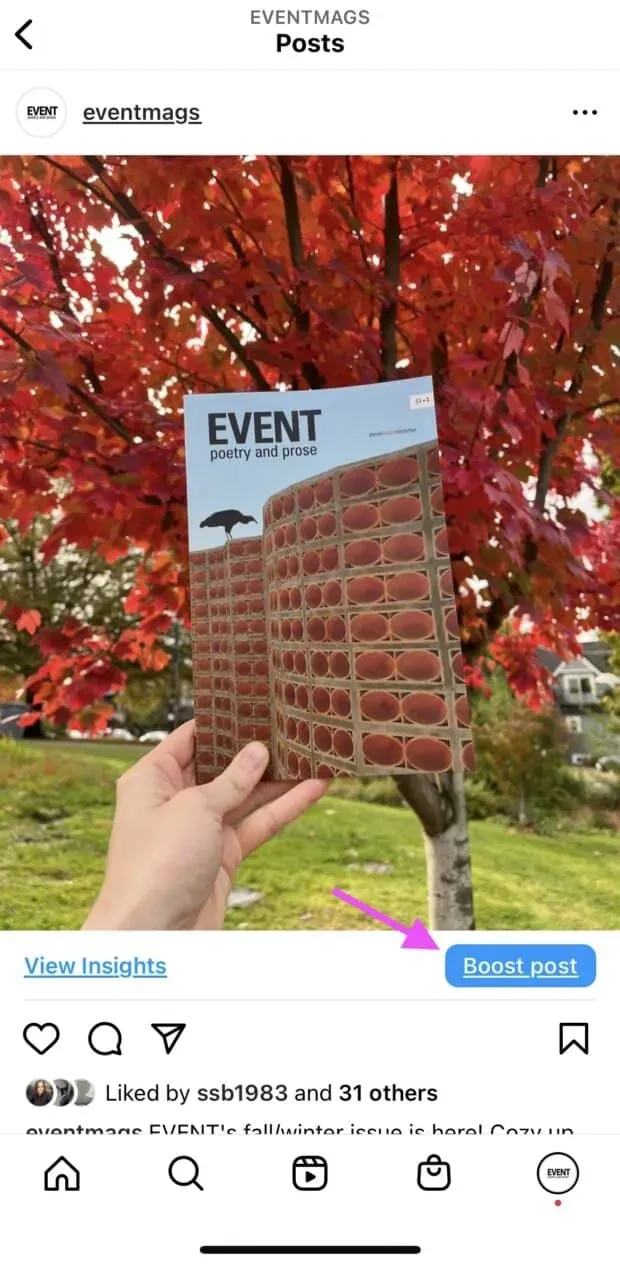
Next, select a target. You will have three options: more profile visits, more website visits, or more messages (including more WhatsApp messages).
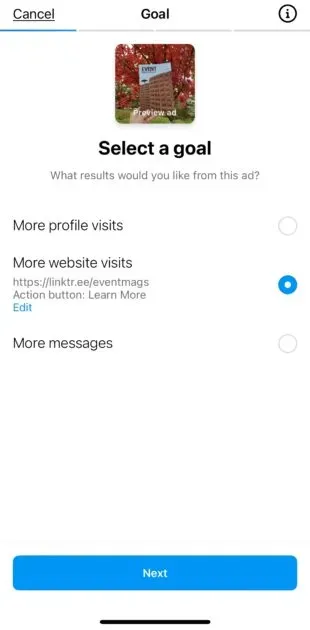
Then define your audience. You can let Instagram auto-detect your audience (based on your followers). Or you can create your own audience by manually entering your targeting options.
You can also run a promoted post on Facebook if you want.

Now select your daily budget and ad duration. You can select a specific number of days or let it run indefinitely until you manually pause it.

Finally, review your ad and click “Speed Up Posting”when you’re ready to post.
That’s all! Your ad will be reviewed and approved by Facebook. Once it’s published, follow the results of your ad in the Promotions tab of your Instagram profile.
Method 2: Use Ad Manager
To get the most out of Instagram’s extensive ad targeting, creative, and reporting options, you can use Meta Ads Manager to create ad campaigns (remember, Meta owns Instagram).
Although it takes a little more work, our 8 step guide will walk you through the process.
Step 1: Create a new Instagram ad campaign.
To get started, go to Meta Ads Manager and click +Create.

Step 2: Choose a target
You can link your ad to an existing campaign or start a new one from scratch. To start a new campaign, you must first select a target.
There are six campaign objectives available for Instagram ads. This:
- Awareness: Reach as many people as possible who are likely to remember your ad.
- Traffic: Send people directly to your website, Instagram store, or app.
- Engagement: Increase views, likes, comments and shares on your Instagram posts.
- Leads: Collect leads for your business with Instagram ads. Or encourage them to share information in exchange for content.
- App promotion: Promote app interactions and installs.
- Sales: Find people who can buy your products or services and increase your sales.
Choose the goal that best suits your goals and click Continue.
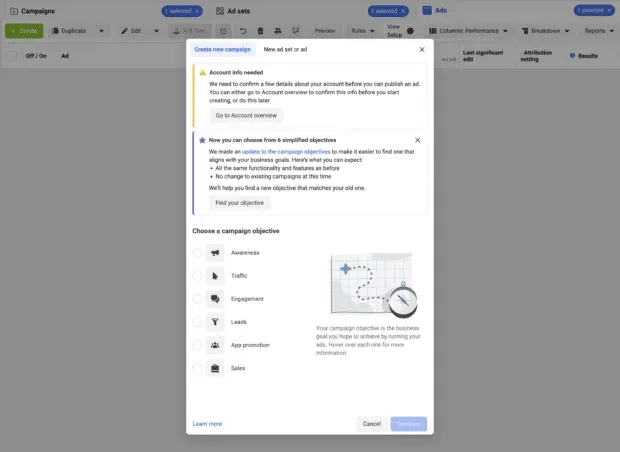
Step 3. Name your campaign
After selecting a goal, you will be prompted to name your campaign.
Pro Tip: Give it a specific name based on the purpose of the campaign so you can keep track of your campaigns.
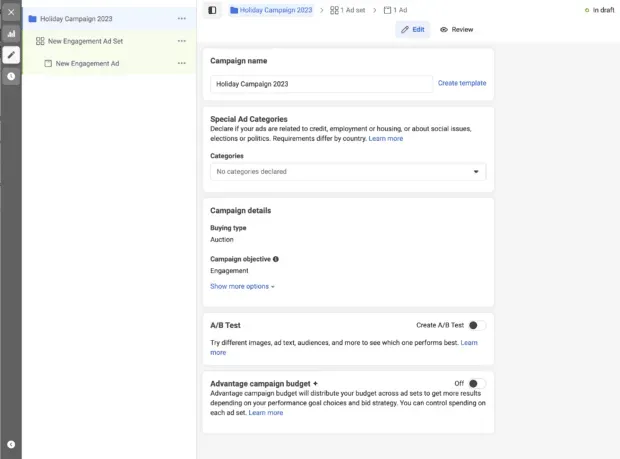
After choosing a name, click Next.
Step 4: Choose a budget and schedule
Once you’ve decided what your ad should look like, select “New [your ad target here]”from the menu on the left.
Here you can choose how much you want to spend and how long your campaign will run.
For your budget, you will have two options:
- Daily Budget: Set a maximum daily spend useful for always-on ads.
- Lifetime budget: Set a maximum spend for the entire campaign, useful for ads with a clear end date.

In the “Ad scheduling”section, you can choose to show ads all the time (the most common option) or only at certain times of the day (for example, if you work in the food delivery industry and want to show ads only in the evening when your audience is most likely to checkout for delivery).
Once you’ve configured these settings, you’ll see the “Audience Definition”and “Estimated Daily Results”modules in the right column, which will give you an idea of the expected reach of your budget.
Pro tip: Try to get your ad group in the middle of the green range.

Step 5: Define Your Audience
Now it’s time to choose your audience.
You can use a previously saved audience or create a new audience.
Saved audiences are useful if you have your own custom audience data (i.e. past website visitors) or past audiences from previous campaigns that performed well. If not, you can create a new audience based on demographics, interests, and behavioral targeting.
If you choose to create a new audience, you will have the option to target by location, age range, gender, demographics, interests, behavior, and language.
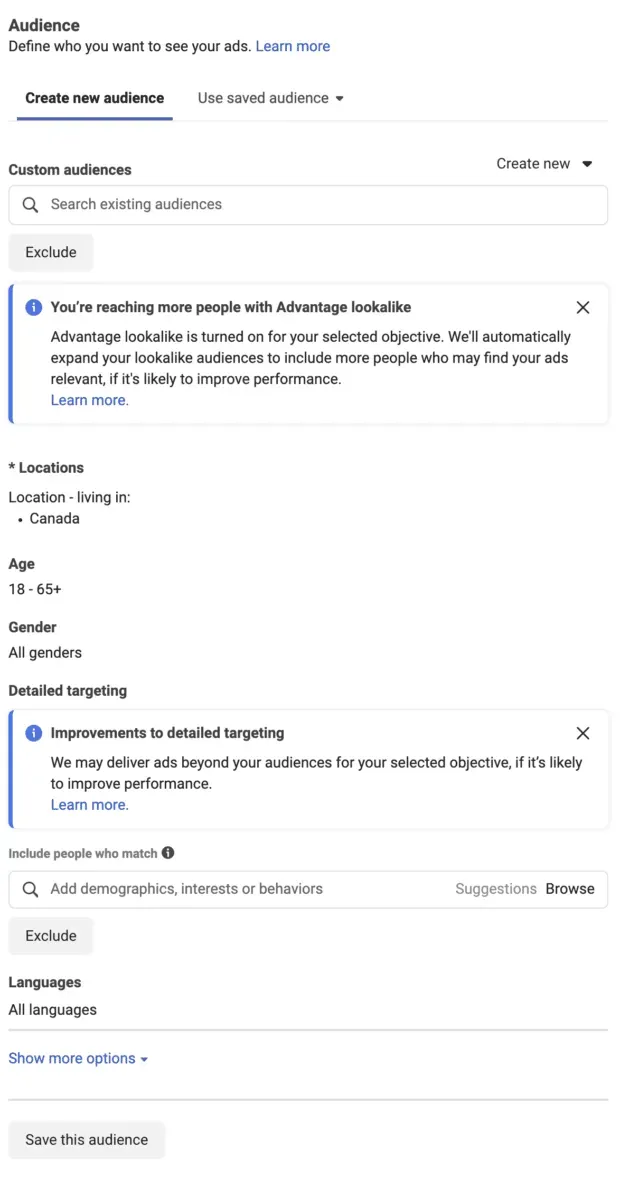
Step 6: Choose your Instagram ad placements.
In the Placements section, you can choose where your ads will appear.
There are two options:
- Advantage+ placements: Ads will be shown to your audience where they perform best.
- Manual placements: You can select a specific placement where your ad will appear (and not appear). If you only want your ads to appear on Instagram (and not on Facebook), you can select them using manual placement.
If you’re new to Instagram advertising, we recommend using Advantage+ placements.

If you select placements manually, Ads Manager displays the technical requirements for each placement. To make sure your visual assets are optimized for each format, check out our guide to social media image sizes.
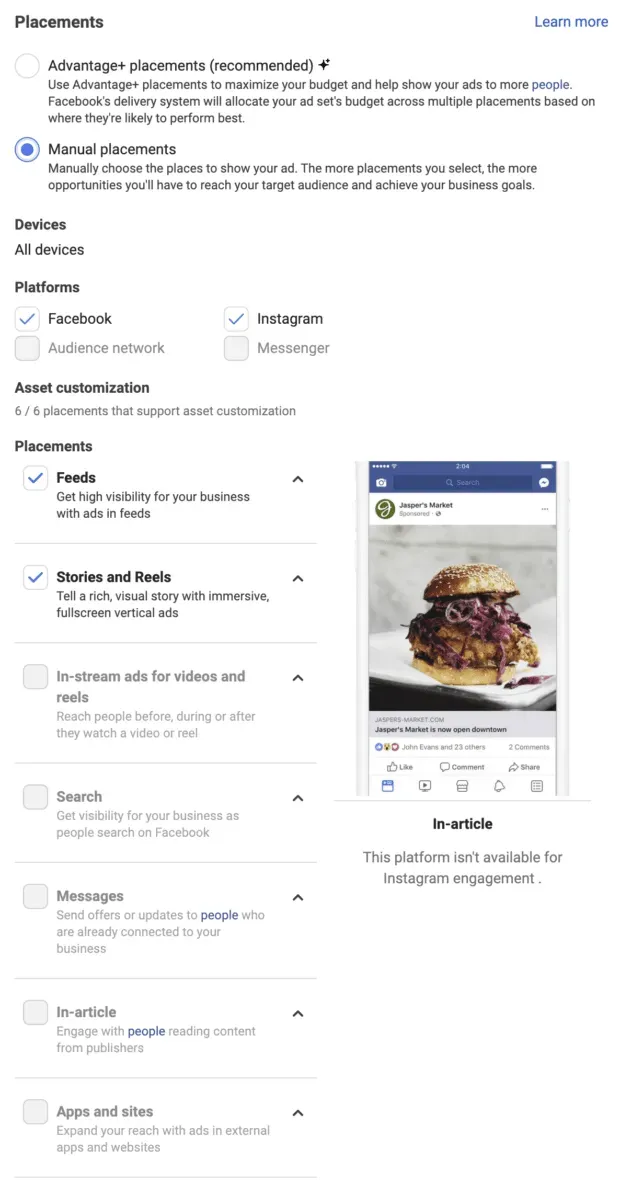
Step 7: Create a New Instagram Ad
Finally, it’s time to create a new Instagram ad. Select “New Listing [your target here]”from the menu on the left. This will open a screen where you can set up your new Instagram ad.
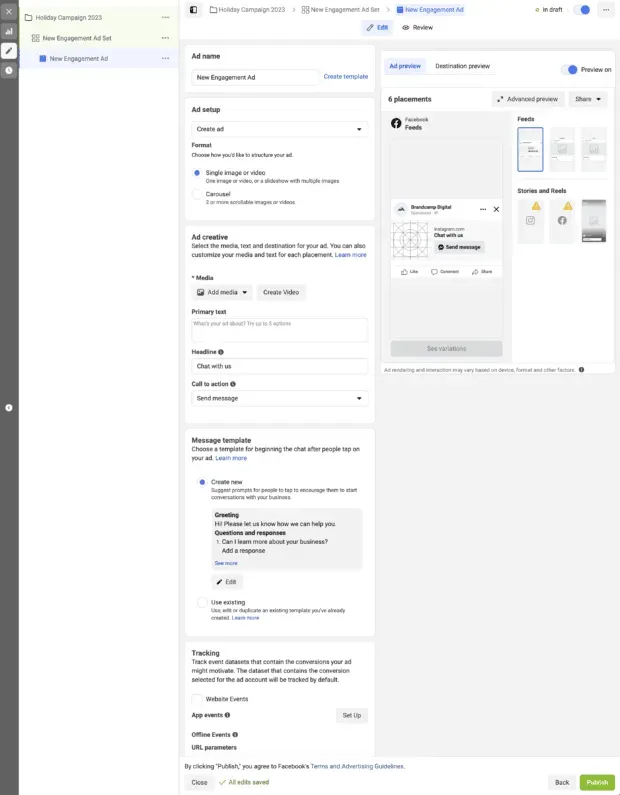
Here you can edit the title of your ad, choose from different types of Instagram ads, and add creative elements such as images, videos, headlines, and calls to action.
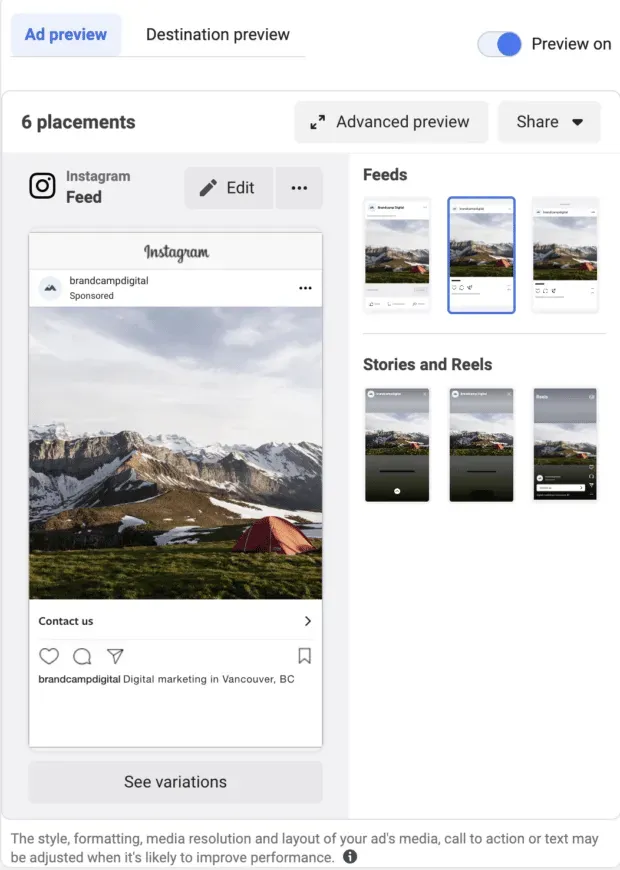
You can also add any copy, website links, and tracking options on this screen.
If you want to track conversions for your ad, it’s important to select the Facebook pixel in the “Tracking”section.
Once connected to your website or app, your Facebook pixel will allow you to see information about how your audience interacts with your business after clicking on your ad.
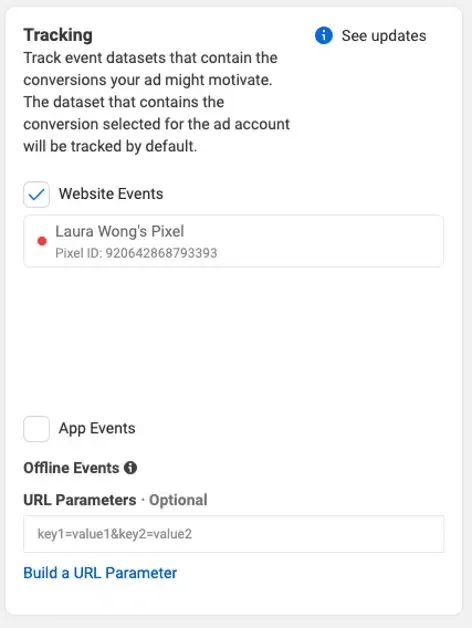
Step 8: Post Your Ad on Instagram
After filling in all the required fields, click “Publish”in the lower right corner of the screen.
Your Instagram ad will now run with the selected budget and schedule. Be sure to check your Instagram analytics regularly to see how your ads are performing.
6 Instagram Advertising Tips
Now you have everything you need to know about setting up and running Instagram ads. The next step is to develop effective visual assets for your ads.
Here are some tips on how to create an eye-catching Instagram ad creative.
1. Create Mobile Ads
With over 4.08 billion users accessing social media through a mobile device, it’s important to design creatives to be viewed on mobile devices, not desktops.
Here are some tips for developing ads for mobile devices:
- When capturing video content, be sure to shoot in vertical format (9×16) as it is easier to crop to 4×5 than in landscape.
- Minimize the amount of text in ads.
- If you add text, choose large font sizes that are easy to read on mobile device screens.
- Add animations and motion graphics to your videos to quickly capture the attention of your viewers.
- Keep videos short (15 seconds or less)
2. Keep branding and messaging upfront
The first few seconds of your ad will determine whether the viewer will stop scrolling and watch the whole thing. That’s why it’s important to start your ad with a key message and showcase your brand within the first 3 seconds.
3. Use sound for fun
The data shows that 69% of users use social networks with the sound turned off. Thus, it is important to create muted ads and use sound to please users who have the sound turned on. Here’s how to do it:
- Use visuals to tell your story and deliver a key message without sound.
- Add subtitles for any voice acting or scripted audio.
- Use text overlays to deliver key messages without sound
4. Serve, play, dive
Facebook recommends developing a combination of ad types that work together to grab attention and encourage interest:
- Presentation: short materials that immediately convey the message of the campaign and attract attention.
- Play: Assets that allow for easy exploration and interactivity for an interested audience.
- Plunge: Immersive resources that let people dive deeper into your campaign idea.
5. Use different types of ads
With so many types of Instagram ads to choose from, you can experiment to find the right mix of visuals and messages that resonate best with your target audience. Consider incorporating video ads, story ads, carousel posts, collections, buyable posts, and more into your advertising approach.
Likewise, get creative with your art! Why not test out some promotional memes or create your own illustrations or GIFs to get your message across? Remember that Instagram ads should reflect the overall aesthetic and style of your brand. But still, there is no reason why you shouldn’t change things to keep your audience interested.
6. Use analytics to see where you are
The best way to know if your Instagram ad is performing well is to measure its performance with analytics. Instagram’s own reporting tool offers information on key metrics such as impressions, clicks, engagement rates, and ROI.
You can also use third-party tools to track your campaign performance in more detail and make data-driven decisions to improve future ad campaigns.
Instagram ad examples
For inspiration, let’s look at some successful Instagram ad campaigns from other brands. As you review these Instagram ad examples, consider the types of visuals used, where ads are placed in stories, and how businesses use text to engage their target audience.
Skip brings its offer to the fore
Skip the crockery knows it only has a few seconds to grab a viewer’s attention, so they don’t waste time telling you what they’re selling. In one simple and effective graph, they show what, why and where.
Source: Instagram (@skipthedishes)
The Bay takes advantage of VR/AR
Today’s online shoppers expect an interactive experience, and The Bay delivers. By combining Instagram Stories ads with VR/AR capabilities, the retailer is creating a unique shopping experience that takes users from the phone to the store.
Source: Instagram (@hudsonsbay)
Birds talk to the stomach
Marketing is based on emotions, right? And what could be more emotional than food? Birdies is doing a great job with their Instagram audience by showing mouth-watering images of their most worthy dishes.
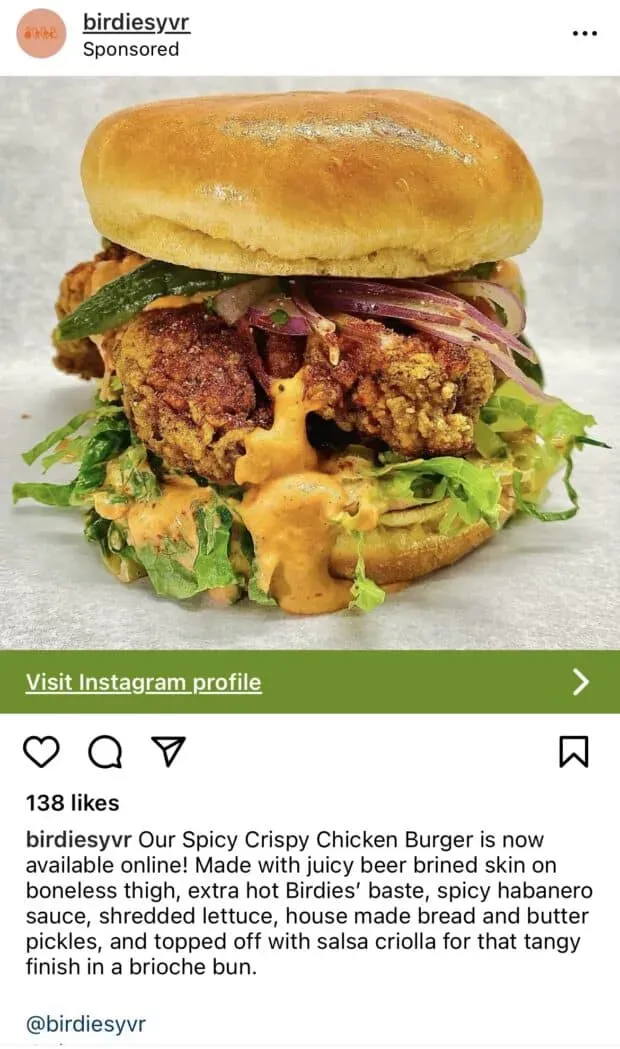
Source: Instagram (@birdiesyvr)
Vessi demonstrates his product in action
Instagram videos, stories, and video ads are a great way to showcase how your product works, especially when it’s a technical subject like Vessi’s new waterproof gloves. Here Vessi uses Instagram Reels ads to show the product in action.
Source: Instagram (@vessi)
Cider makes it easy
You don’t have to break the bank every time you create an Instagram ad. Graphic advertising for clothing brand Cider is simple yet effective. They will show you the product and tell you why you should buy it. It shouldn’t be more complicated than that.

Source: Instagram (@cidergang)
Dank Mart uses collaborative posts to create buzz
Instagram now allows brands to create collaborative posts. These messages will show two account names – the brand and its partner – and links to both accounts. Canadian specialty snack store Dank Mart used the feature to advertise a new product with its future partner, Nemesis Coffee.

Source: Instagram (@dankmart)
Storyworth turns customer reviews into ads
Social proof is the idea that seeing other customers use and recommend a product makes you more likely to buy it. a company that helps you write your family’s story into a book has taken advantage of this idea by using customer videos in their ads. By showing the grandparents opening the gift for the first time, they created personalized emotional Instagram ads that shoppers could love.
Source: Instagram (@storyworth)
Looking for more inspiration? Check out the Facebook Ads Library to see how other companies advertise on Instagram. You can search Instagram ads by keyword and get a better idea of how different brands are approaching the platform. From there, you can confidently test your campaigns knowing what is already working for others in your industry.


